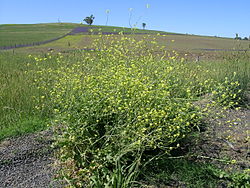| Hirschfeldia | |
|---|---|
 | |
| Scientific classification | |
| Kingdom: | Plantae |
| Clade: | Tracheophytes |
| Clade: | Angiosperms |
| Clade: | Eudicots |
| Clade: | Rosids |
| Order: | Brassicales |
| Family: | Brassicaceae |
| Genus: | Hirschfeldia Moench |
| Species: | H. incana |
| Binomial name | |
| Hirschfeldia incana | |
| Subspecies [1] | |
4, see text | |
| Synonyms [2] [1] | |
List
| |
Hirschfeldia incana (formerly Brassica geniculata) is a species of flowering plant in the mustard family known by many common names, including shortpod mustard, buchanweed, hoary mustard [3] and Mediterranean mustard. [4] It is the only species in the monotypic genus Hirschfeldia, which is closely related to Brassica . [5] The species is native to the Mediterranean Basin but it can be found in many parts of the world as an introduced species and often a very abundant noxious weed. [6] This mustard is very similar in appearance to black mustard, but is generally shorter. [7] It forms a wide basal rosette of lobed leaves which lie flat on the ground, and it keeps its leaves while flowering. [8] Its stem and foliage have soft white hairs. Unlike black mustard, H. incana is a perennial plant. [7]
Contents
Its leaves are edible and traditionally were used in some areas as a leaf vegetable. [9]